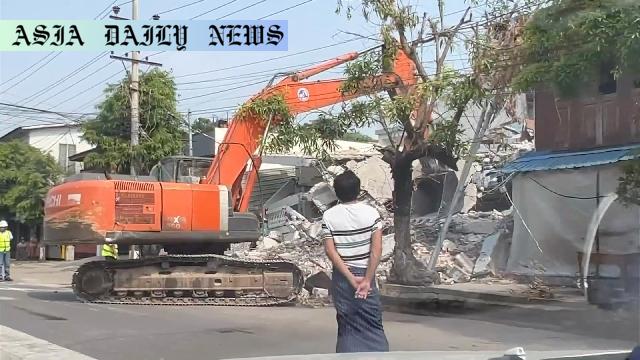Myanmar Earthquake: Survivors face devastating living conditions with over 3,700 deaths and 60,000 homes affected.
- Myanmar Earthquake caused over 3,700 deaths and displaced thousands.
- Around 60,000 homes have been destroyed or sustained damage.
- Survivors face dire conditions with limited food, shelter, and medicine.
- Fears of aftershocks prevent families from returning to homes.

The Massive Impact of the Myanmar Earthquake
On a tragic morning one month ago, central Myanmar was struck by a powerful magnitude 7.7 earthquake. Its devastating magnitude wiped out livelihoods, flattened communities, and left survivors grappling with unimaginable loss. Today, the haunting aftermath is still visible, as life for many remains a constant struggle. Official reports highlight the staggering toll — over 3,700 lives lost, and approximately 60,000 homes either fully or partially destroyed. The affected regions are a grim reminder of how vulnerable communities can often bear the brunt of natural calamities.
Survivors Forced to Live Outdoors
Families whose homes were destroyed or rendered uninhabitable now seek shelter in makeshift tents erected in open spaces, such as parks and town squares. For countless individuals, the risk of aftershocks has instilled a pervasive fear, preventing them from returning to whatever remains of their former homes. In Mandalay, the 64-year-old resident testifies to sleepless nights and aching uncertainty. Despite efforts by local and international aid agencies, the severe shortage of medicines, clean water, and food poses ongoing risks to the health and wellbeing of survivors.
Personal Loss Amplifies the Tragedy
Adding a layer of heartbreak to the collective suffering are the personal stories of loss and grief. In Mandalay, a man already displaced by military conflict in Kachin now faces an overwhelming reality: the deaths of his wife and child during the quake. As he mourns, he expresses a communal spirit of resilience, acknowledging the hardships shared by others while committing himself to helping rebuild his community. Such stories resonate deeply, acting as a testament to the human spirit amidst chaos and tragedy.
Challenges in Infrastructure and Healthcare
The northwest region of Sagaing, which bore the brunt of the earthquake, presents a dismal picture of devastation. Basic infrastructure, such as electricity systems and water supply lines, is non-operational in many areas. Hospitals, overwhelmed by the influx of patients, are barely able to provide adequate care. Humanitarian aid organizations have stepped into the void, but their resources are limited compared to the overwhelming needs on the ground. The debris-strewn streets and flattened houses serve as stark reminders that full-scale reconstruction is still far from reality.
The Path to Rebuilding
Myanmar’s recovery process is an uphill climb, made even more difficult by political instability under the military junta. Despite these challenges, continued support from international and regional actors is critical. Aid in the form of food supplies, temporary shelters, and healthcare services is desperately needed to heal the wounds of a nation. Support systems must also extend beyond physical needs to address long-term mental health impacts, as many survivors endure post-traumatic stress. Urgent and sustained collaborative efforts are essential to bring hope and stability to this stricken community.



Commentary
Understanding the Human Cost
The catastrophe in Myanmar serves as a sobering reminder of the devastation natural disasters can bring to vulnerable regions. While statistics such as death tolls and damaged homes provide a numeric snapshot of its magnitude, they fail to capture the depth of human suffering experienced on the ground. These are people who once lived vibrant lives, full of dreams and aspirations, now struggling to find a semblance of normalcy amidst open skies and debris.
The Importance of Immediate Aid
The outpouring of international condemnation, sympathy, and financial aid often dissipates quickly after the headlines fade. However, this cannot be the case for Myanmar. The survivors’ needs are urgent, multifaceted, and unmet. Immediate aid addressing shelter, food, healthcare, and water resources is not merely a form of charity—it is a moral imperative for the global community. Accounts from humanitarian organizations paint a stark picture of failing infrastructure and overburdened medical facilities. Resources must be mobilized efficiently to prevent even greater loss of life.
Long-Term Concerns and Mental Health Support
Furthermore, rebuilding efforts must extend into the psychological realm. Post-traumatic stress, compounded by the loss of loved ones and continual displacement, is a harrowing reality for many survivors. The resilience of the man who lost his family in Mandalay showcases the human spirit’s strength, but it also reflects an urgent need for structured mental health aid. Policymakers and aid groups must not overlook this vital aspect if true recovery is to be achieved.
Final Thoughts
Myanmar’s earthquake highlights the intertwining vulnerabilities of natural disasters and socio-political instability. Yet, it also underscores the power of human solidarity and endurance. As Myanmar grapples with this calamity, the international community must rally behind its people, channeling robust aid and expertise. Let this tragedy spark global attention towards building disaster-resilient communities and fostering compassion across borders.